Motion And Measurement Of Distances
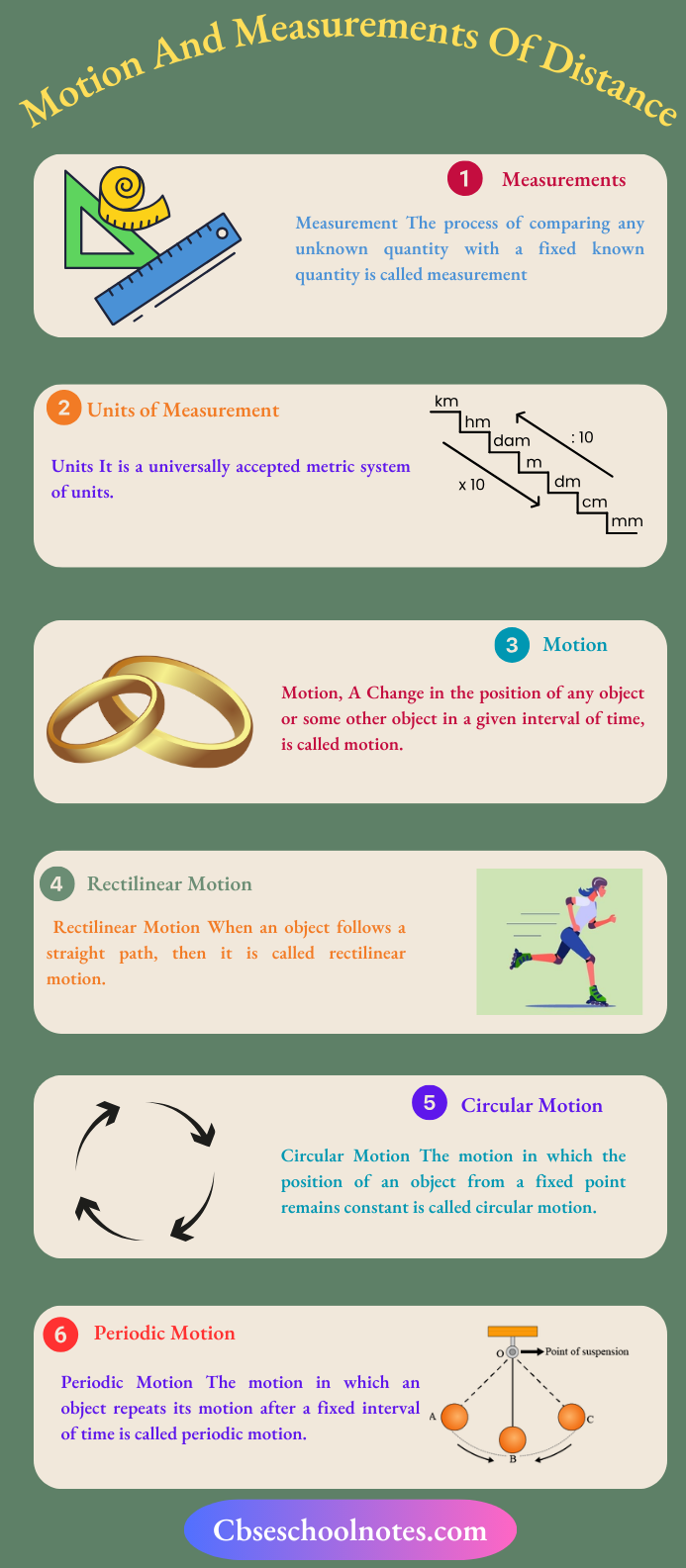
Motion And Measurement Of Distances Story Of Transport
A way to carry people and goods from one place to another is called transport. We will now discuss how people traveled and carried goods from one place to another in earlier times and how they do it these days.
- In ancient times, people did not have any means of transport. They used to move only on foot and carry goods on their back. Later on, they began to use animals for transportation.
- For transport through water routes, boats were used from ancient times. Boats were simple logs of wood in which a hollow cavity could be made. Later, people learned to put together different pieces of wood and gave shapes to the boats. These shapes imitated the shapes of the animals living in water.
- After many years, man invented the wheel, which led to the discovery of wooden carts and sleds that helped man to transport goods on land and ice. Later, they used animals like horses and camels to pull the wheels. The invention of the wheel also led to the discovery of the bicycle.
- In the beginning of the 19th century, the invention of the steam engine introduced a new source of power to run transport vehicles.
Read and Learn More Class 6 Science Notes
Steam engines (which used coal as fuel for making steam) were used to pull trains on railroads (railway tracks) for carrying people and goods from one place to another. Steam engines were also used to run ships in the beginning.
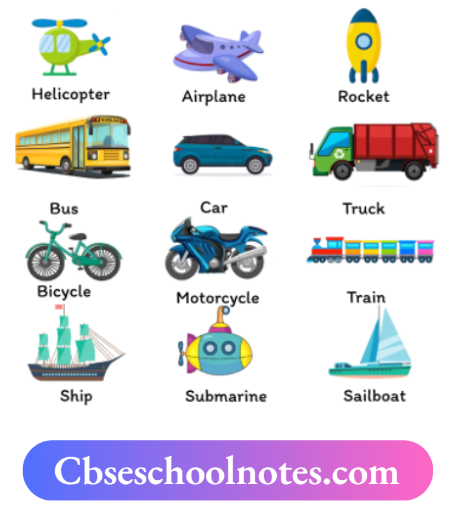
Science insight:
James Watt (a Scottish engineer) invented the steam engine in 1756. The steam engine is called an external combustion engine because the fuel ; (coal) for making steam was burnt outside the engine.
- After a few years, the invention of the internal combustion engine (which uses petrol or diesel as fuel) gave us transport vehicles, which are known as automobiles (cars, buses, scooters etc.) for travel on land.
- On the other hand, motorized boats and ships were developed as means of transport on water.
- In the early years of 1900, aeroplanes were discovered as a means of transport which are also considered as the fastest means of transportation for goods and people.
- Electric trains, monorails, supersonic airplanes and spacecraft are also some of the 20th-century contributions to the modes of transport.
Need of Measurement
There are so many occasions when we come across a need to measure distance and length, e.g.,
- If you want to go to your friend’s house or the market, the first thing you want to know is the distance between your house and the place.
- The tailor needs to measure the length of the cloth to know if it is enough to stitch a kurta.
So, we can say that distance or length is the measure of how far or long something is. In other words, the actual path length covered by an object between two points is called distance.
Measurement
Measurement is the. method of comparison of any unknown quantity with a known quantity. This known quantity is known as a unit.
- The result of measurement is expressed in two parts, i.e. a number and a unit of the measurement.
- For example, we measured the length of the desk as 2 meters. In this case, the first part is a number that is 2 and the second one is a unit that is a metre.
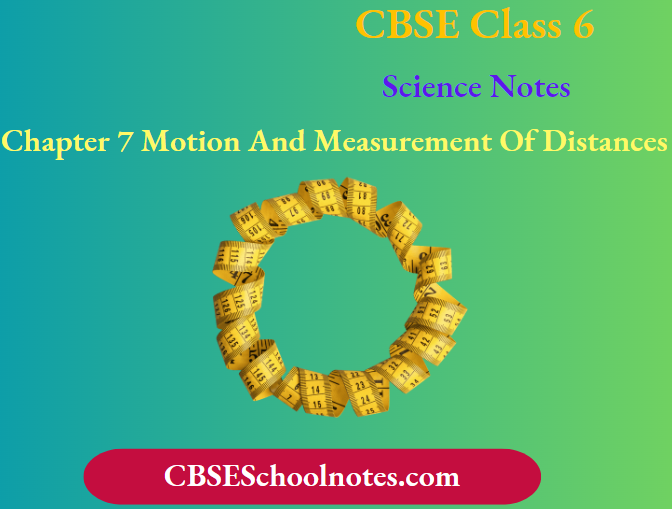
Ancient Methods of Measurement
In ancient times, people used the following different units for the measurement of length and distance.
1. Handspan
Hand span is the length between the tip of the thumb and the little finger of our hand when we stretch it as shown in the figure.

2. Cubit
Cubit is the length between the tip of the middle finger and the elbow when we stretch our hand horizontally. It was used to measure length in ancient Egypt.
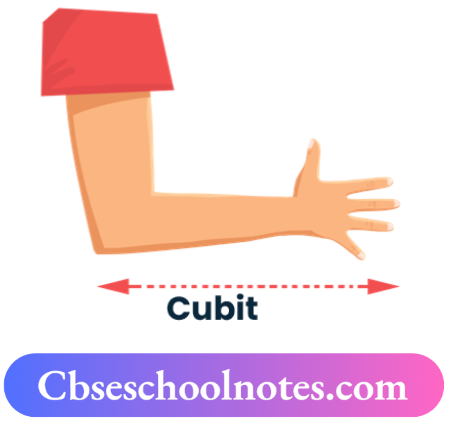
3. Yard
Yard is the length between the tip of the middle finger and the chin of an outstretched arm. It was used to measure the length of clothes and wires.

4. Footstep
The footstep is the length between the thumb and the heel of the foot. We used this method to measure the distance.

5. Mutthi
Mutthi (Fist) refers to the quantity that a person’s fist (mutthi) can hold. It was used to measure quantities of small things like wheat, rice sugar, etc.

6. Angul (finger)
Angul is the width of a finger. It was used to measure very small distances with the help of fingers. You may heard from your grandparents, it is the gap of chaar angul (four fingers).

Standard Units of Measurement
The ancient methods of measurement were inaccurate and changed from person to person. Hence, to have a fixed value for a unit of measurement, standard units of measurement were developed.
The standard system of units is called the SI system (System International and Units in French).
1. The SI unit for measuring length is a meter (m).
1 m = 100 cm, 1 cm = 10 mm
2. For long distances meter is not a convenient unit, hence we define a larger unit of length that is a kilometer (km).
1 km= 1000 m
3. The smallest unit to measure length is fermi (fm).
⇒ \(1 \mathrm{fm}=\frac{1}{10^{15}} \mathrm{~m}\)
Correct Measurement of Length
For measurement, usage of the correct device is very important,
Example:
You cannot measure the girth of a tree or the size of your chest using a meter scale. For this, measuring tape is more suitable. So, for measurement, usage of the correct device and way of measuring things plays a vital role.
1. Precautions while Taking Measurements:
For taking measurements, we must take care of the following things
1. To take measurements of the length of the object, we must put the scale along its length as shown in the figures.

2. If the end of the scale is broken and we are not able to see a zero mark, then take any full mark and subtract the reading of this mark from the reading at the other end as shown in the figures.
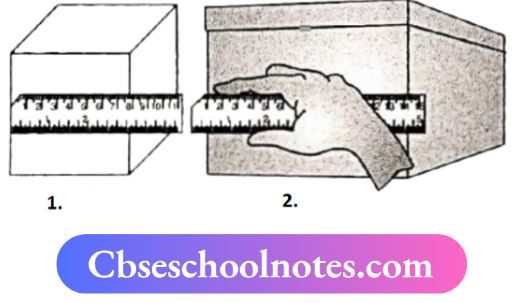
3. During measurement, the position of the eye is also very important. So, we must keep our eyes in such a way that it is exactly in front of the point where the measurement is to be taken as shown in the figure.
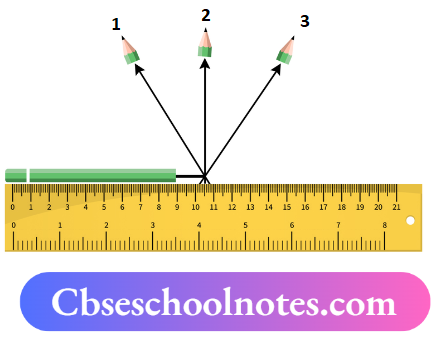
2. Measuring the Length of a Curved Line:
We cannot measure the length of a curved line directly by using a meter scale. We can use a thread to measure the length of a curved line. If we carefully move the thread along the curved line while keeping it stretched tightly and then measure the used part of the thread by a meter scale, we can get to know the length of the curved line.
Moving Things Around Us
When a body changes its position concerning time, then it is said to be in motion, e.g. moving ant, the hands of the clock, a running car, the revolution of the earth around the sun, etc.
On the other hand, when a body does not change its position concerning time, then it is said to be stationary or at rest.
Example: Table, house, tree, etc.
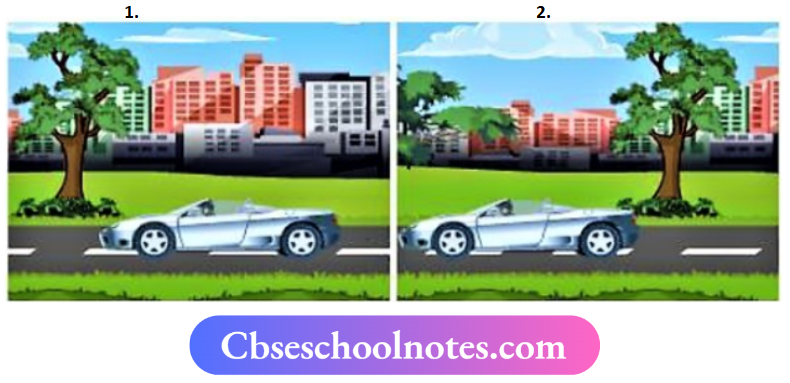
Types of Motion
- When we see around us, we experience the motion of a vehicle, the march past of soldiers, the running fan the motion of a bicycle, etc.
- Different objects show different types of motion. Some of the circular motion is periodic but a periodic motion may or the important types of motions stated as follows may not be circular
1. Rectilinear Motion:
A body is said to be in rectilinear motion, if it moves in a straight line without changing its direction of motion, e.g. Vehicle running on a straight road, the motion of a bullet when fired, sprinters in a 100 m race, march-past of soldiers, etc.

2. Circular Motion:
A body is said to be in a circular motion if it moves in a circular path around a fixed point,
Example: Hands of a clock, the motion of a stone in the following figure. In this case, the distance of the stone from your hand is not changing because the length of the string is not changing.
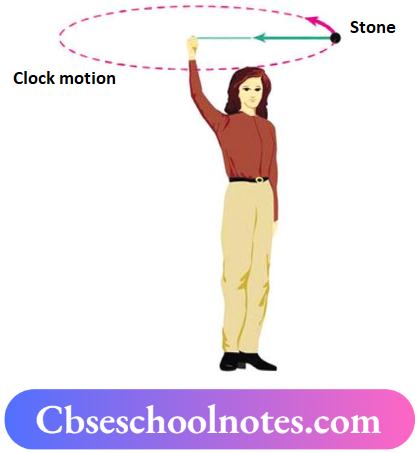
3. Periodic Motion:
The motion which repeats itself after a regular interval of time is known as periodic motion,
Example: The motion of the minute hand of our wristwatch, the motion of a simple pendulum, revolution of planet around the sun.

Note You might have observed some objects possess more than one type of motion, e.g. sewing machine remains at rest while its wheels move in circular motion and the needle moves in periodic motion.
Activity 1
Aim:
To measure the length and width of the classroom by foot
Material Required:
Classroom and 3 friends.
Procedure:
- Place your foot along the length of the classroom.
- Now, put your second foot next to your first foot without leaving any space between the two feet.
- Now, put your first foot next to your second foot
- Repeat this process until you reach the other side of the floor.
- Similarly, measure the width of the classroom. If some part remains to be measured as it is smaller than your foot, then use a string to measure that part of the length.
- Ask your friends to do the same procedure.
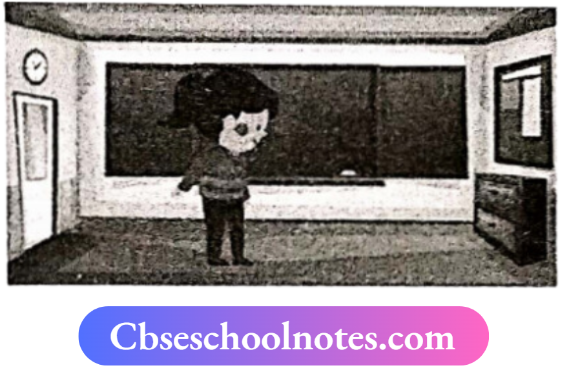
Now, make an observation flow chart as follows:
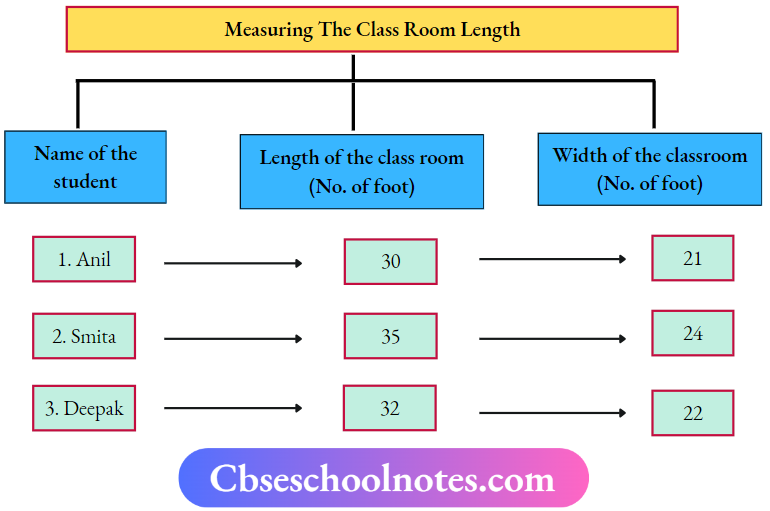
Conclusion:
Length and breadth are not the same, it varies from person to person.
Activity 2
Aim:
To measure the width of the table with a handspan to know about the unit.
Material Required:
A classroom table and 3 friends.
Procedure:
- Place your thumb on the left corner of the table as shown in the figure. Now, measure the complete width of the desk using your handspan.
- Count the number of handspans
- Now, ask your friends to do the same.
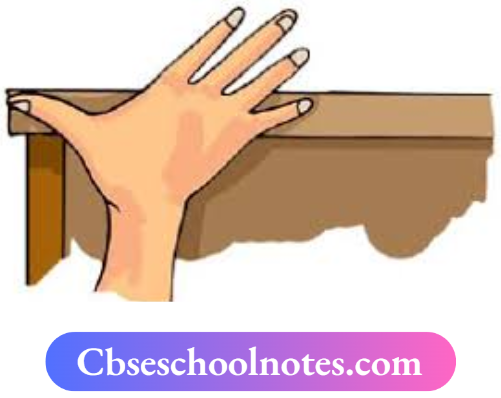
Record all the observations in a flow chart as shown below:

Conclusion Handspan is a known quantity and the width of the table is an unknown quantity. The measurement of the width of the table is different for different people.
Activity 3
Aim:
To measure the height of your friend using a handspan and then by using a meter scale.
Material Required:
1 marker, 1-meter scale and 3 friends.
Procedure:
- Ask one of your friends to stand with his back against a wall
- Make a mark exactly above your friend’s head.
- Measure the distance of this mark from the floor using handspan and then with a meter scale
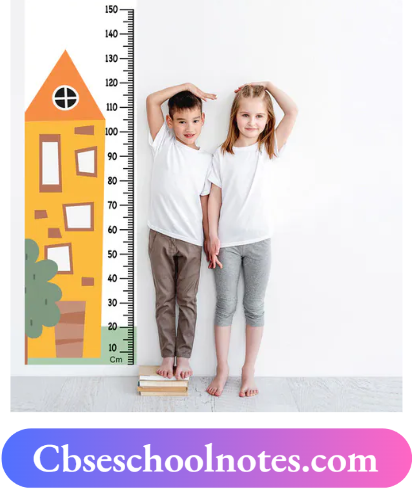
Ask other friends to do the same flow chart:
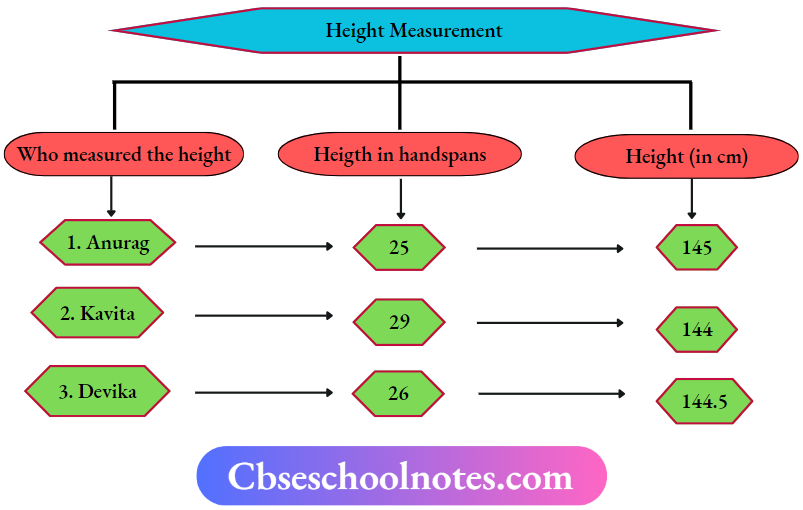
- Now, record all the observations in a table as shown below Conclusion Height in handspan is different for different students because the length of their handspan is different.
- Height in cm is approximately the same. It varies slightly due to errors while marking.
Activity 4
Aim:
To measure the length of a curved line using thread.
Material Required:
A thread, a marker and a meter scale.
Procedure:
- Put a knot on the thread near one of its ends.
- Place this knot on the point A. Now, place a small portion of the thread along the curved line. Place a finger on the thread to hold it there.
- Using the other hand, stretch the thread a little more
- Repeat this process till the other end 2 and mark on a thread where it touches point 2.
- Now, stretch the thread along a meter scale and measure the length between the know and the final marker

Conclusion:
The length of the curved line from point A to point B is 10.2 cm.
Activity 5
Aim:
To identify objects in motion and objects at rest.
Material Required:
3-4 blank papers and pen
Procedure:
- Go to different rooms of your house and make a list of different objects that you see.
- Now, visit any nearby park and make a list of objects that you see.
- Now, visit any nearby market and again make a list.
- Now, divide all the objects into two parts.
- The first part is objects at rest and the second part is objects in motion.
Crowd Park:

Observation of the flow chart:
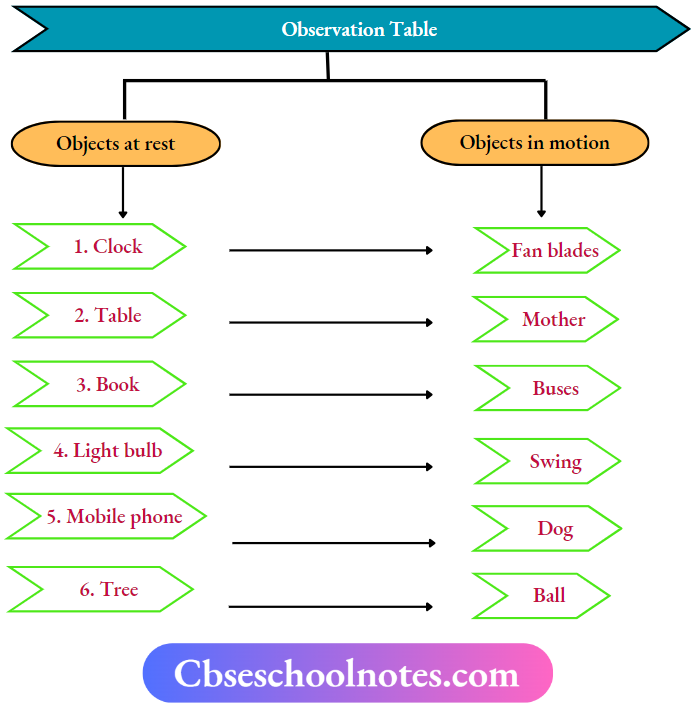
Conclusion:
From this activity, we concluded that some objects change their position like flying birds, balls, etc., and these objects are in motion. Some other objects do not change their position e.g. table, bench, etc., these objects are at rest.
Activity 6
Aim:
To understand the meaning of motion by observing an ant.
Material Required:
Sugar cubes, a clear white paper of large size, and a gel pen.
Procedure:
- Visit your nearby garden and find a place where ants are present.
- Now, spread the white sheet near the ants and spread some sugar cubes on it.
- When any ant starts moving on the paper, make a small mark near its position.
- Keep marking its position after every few seconds as it moves along the paper.
- After some time, shake the paper to make it free from sugar and ants. Connect all the marked points with arrows to show the direction in which the ant moved.
- Conclusion From this activity, we concluded that the ant has changed its position after some time and the path of the ant is not definite.
Activity 7
Aim:
To observe the motion of a whirling stone.
Material Required:
A small stone and a strong string.
Procedure:
- Tie the stone with a string that you have.
- Now, hold the other end of the string.
- Now, whirl it with your hand and observe the motion of the stone. You will find that it is moving in a circular path.
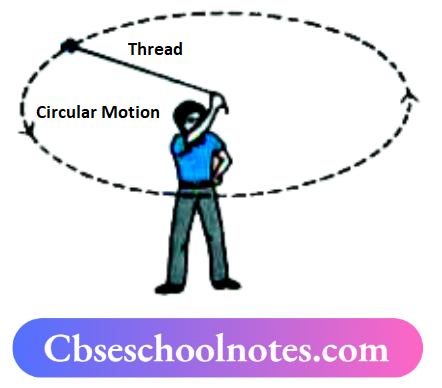
Conclusion:
We concluded that the motion of the whirling stone is circular.
